Good, workable test gear is key to enabling our hobby. In this post we will discuss where to procure it at rock-bottom prices, what to look for, how to fix it, and how to tailor your laboratory practices around gear that may not be reliable.
We are lucky to be living in an era with plentiful high-quality test gear. Since the Second World War, surplus test gear has been in abundance at low costs enabling hobbyists, innovators, and academics to experiment and build great things. If you are willing to think before you measure you can save serious amounts of money and have a professional laboratory in your home.
Where to buy
The obvious answer is eBay, but the deals on test equipment are at the hamfests. Don’t be fooled by the name. Hamfests sell much more than amateur radio equipment. Hamfests are swap meets where hobbyists trade electronics of all kinds. Check out the ARRL hamfest calendar to find the next local one near you! I suggest you arrive early, however. The culture of hamfests tends to favor showing up as soon as the doors open and leaving about two hours before the official end. The early bird gets the worm!
You will have to go to a number of hamfests before you will find everything you need. Patience is key. Just keep going to hamfests and eventually you will find it or something close. If you need it now you can pay more on eBay and equip yourself very quickly.
Of course there is the mother of all hamfests, the Dayton Hamvention. As I’ve heard many times, if you can’t find it at Dayton you don’t need it.
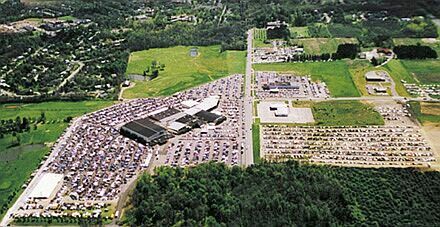
What to look for – brands & eras of quality
If you are looking for a scope then buy a Tektronics brand, any era. Some of the ‘TV Repairman’ scopes are not bad either. I’ve had good luck with my Heath-Zenith from the late ‘80’s. If the scope is not a Tek or an HP then judge the equipment based on cleanliness. If it’s very clean then it’s worth a try; if dirty then buy two and one will likely work!
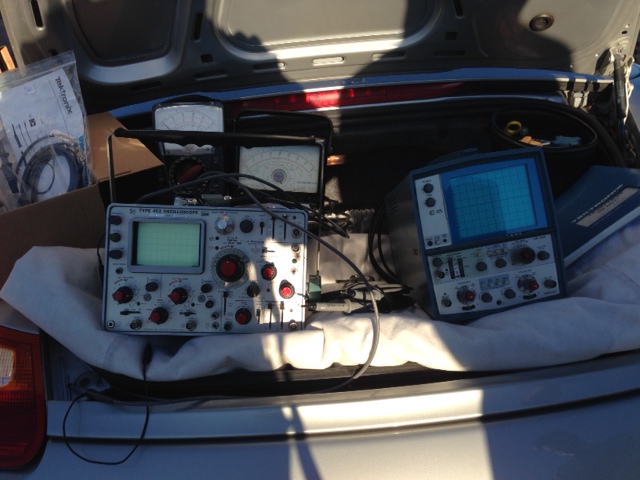
For everything else, buy Hewlett-Packard whenever possible. In my experience, tube HP signal generators from the ‘50’s and ‘60’s tend to be very reliable. To no surprise, when you pop the covers off one they seem to be built to some very high specification. Some of the more complex gear from the ‘70’s and ‘80’s can be difficult to service, requiring difficult-to-find card extenders and such. I only buy this gear if it’s clean, and I try to get two whenever possible.
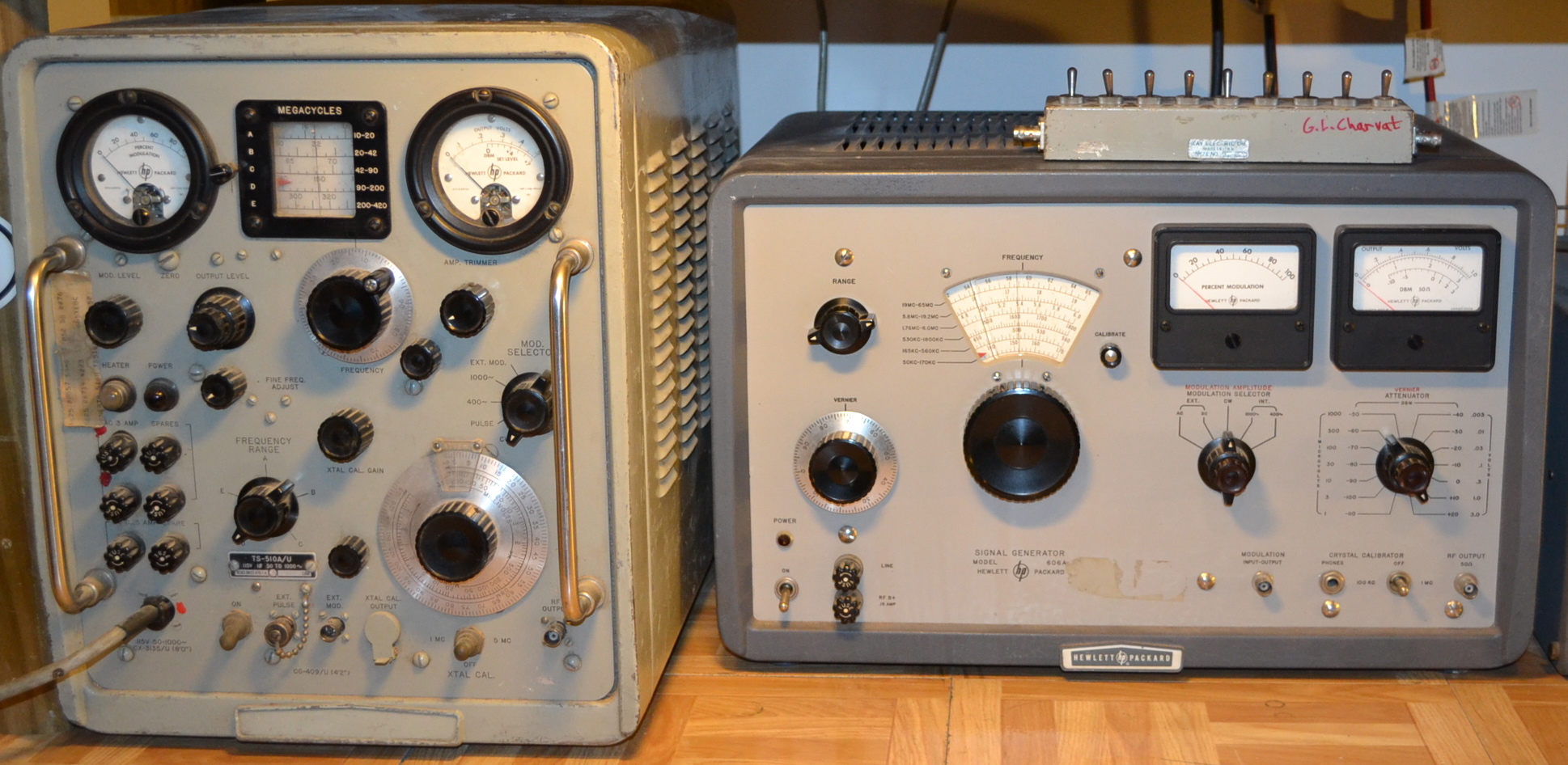
Generally speaking, if you must get any particular piece of gear try to buy two to spread your risk. Expect hamfest test gear to work 60-70% of the time.
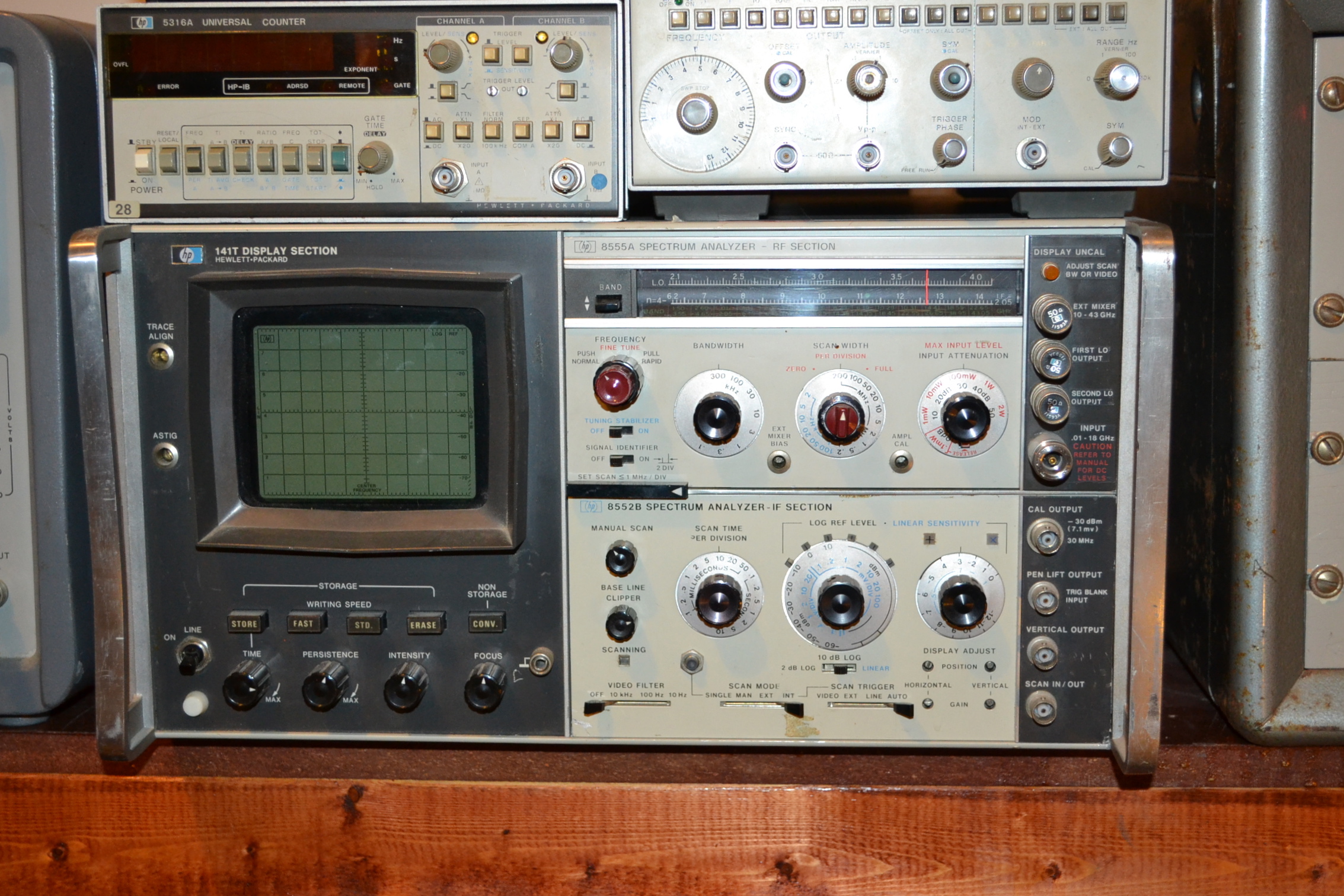
Fix it or replace it?
Over time your working test gear will break down. You can either replace it or fix it yourself. This is simply a trade of time for cost. More time spent maintaining your gear, the less you will pay out of pocket to procure and keep your lab running. While in graduate school, my policy was to spend no more than 3 hours repairing the equipment, and if I exceeded this time without any tangible progress I would replace it. My current approach is to buy used gear at hamfests and run it until it dies. If it dies I replace it with another used piece of gear. To make up for the gap in time replacing the equipment, all of my gear has overlapping capability so I’m never without the right instrument for the job.
There are groups dedicated to the repair and restoration of Tektronics scopes and probably others for HP gear too.
For some tube gear such as the Heathkit and other lower-end TV and radio repair gear, you can just use the antique radio repair procedures previously discussed – Making old Heathkit and other old gear very repairable for many decades to come.
Think before you measure – some guidelines for using old gear
Trust nothing! When using old test gear of any type you must tailor your measurement procedures so that you are always verifying. When your circuit is not behaving as expected, the first thing you should do is verify power (all voltages and ground), verify cables, verify outputs of test gear, and verify inputs are working on your test gear. Don’t let a loose BNC input connector on your hamfest scope or a bad test cable fool you into thinking that your amplifier is dead. This is a basic trouble shooting skill extended to your measurement setup (many of you may already do this intuitively).
Example – a microwave laboratory
Microwave test gear is not cheap. Starting in high school, I began to procure test gear, anything at first, and slowly upgraded to better, more reliable equipment over time. This laboratory began turning out serious projects culminating in my PhD thesis, which included two Synthetic Aperture Radar rail imaging systems and a near-field phased array. This lab continues to support all of my work both as a hobbyist and professional. As you can see it is supplied with gear from the 50’s, 60’s, 70’s and the newest stuff is from the 80’s.
Prices, based on what I’ve previously bought and observed
The heavier it is the cheaper it is, for example tube RF signal generators in working condition typically fetch <$100.
Good scopes (Tek brand, 50-100 MHz of bandwidth 2 or more channels) range from $50-$200. Higher the bandwidth the more the scope will fetch, although i once bought an old sampling scope with 2.5 GHz of bandwidth for $100.
Function generators can fetch $20-$50.
Good spectrum analyzers, such as ones based on the HP 141T mainframe, run about $400-$1200 in working condition.
HP microwave signal generators go for $300 and up.
Bench supplies, such as lower power HP Harrison types, $20-$50 each.
Good digital Voltmeters, such as Fluke or Simpson 260’s, $20-$50.
Summary
We live in a world full of old test gear and all we have to do is think before we measure. Tackle increasingly more complicated array of projects. Don’t wait until you can visit a friend or go into work to measure something. Instead, have in-house capabilities. Visit your local hamfest and build up a professional lab in your basement or garage today!
References
Acknowledgement
My cousin, Juliet Hurley, MBA, MSF, MAC for type-editing this post.
Author bio
Gregory L. Charvat, is the author of Small and Short-Range Radar Systems, co-founder of Hyperfine Research Inc., Butterfly Network Inc. (both of which are 4combinator companies), visiting research scientist at Camera Culture Group Massachusetts Institute of Technology Media Lab, editor of the Gregory L. Charvat Series on Practical Approaches to Electrical Engineering, and guest commentator on CNN, CBS, Sky News, and others. He was a technical staff member at MIT Lincoln Laboratory where his work on through-wall radar won best paper at the 2010 MSS Tri-Services Radar Symposium and is an MIT Office of the Provost 2011 research highlight. He has taught short radar courses at MIT where his Build a Small Radar course was the top-ranked MIT professional education course in 2011 and has become widely adopted by other universities, laboratories, and private organizations. Starting at an Early Age, Greg developed numerous radar systems, rail SAR imaging sensors, phased array radar systems; holds several patents; and has developed many other sensors and radio and audio equipment. He has authored numerous publications and has received press for his work. Greg earned a Ph.D in electrical engineering in 2007, MSEE in 2003, and BSEE in 2002 from Michigan State University, and is a senior member of the IEEE where he served on the steering committee for the 2010, 2013, and 2016 IEEE International Symposium on Phased Array Systems and Technology and chaired the IEEE AP-S Boston Chapter from 2010-2011.

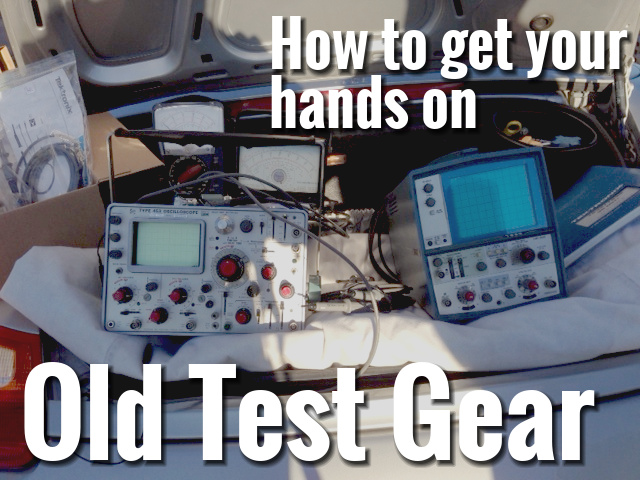






























In before the “this is not a hack” crowd, but applause for old test gear. I’ve owned some of the HP microwave generators shown in the pictures. You’re not going to get 6 digits of frequency accuracy, but power levelling is remarkably good over the frequency range. I’m also a ham radio operator, and have been to the Dayton Hamvention several times. Yes, the flea market there is legendary.
The other great thing about ham fests is that you can take your old test gear and sell it. On a good day you might break even!
Once I ham I knew bought a 2M vertical antenna antenna at a ham fest, he took it back. He took it back to the table where he and othr hams where trying to sell stuff, and back to wandering the flea market for other items he wanted. By the time he returned to his table the antenna was gone, the hams sold it for him. He made money,but he didn’t have the antenna he though he needed.
i grew up in vandalia, ohio where the hamvention takes place. every year the city turns into a sea of cars with giant antennas!
Already working on my home lab, I want a big component rack like other labs so I don’t need to wait up to 17 business days for a part!
When avoiding hamfests, beware of the crotchety old men who’ll wisdom your ear off for hours. Don’t mention soldering versus crimping for connectors. No matter what, don’t believe that the PL-259 is anything other than trash.
“No matter what, don’t believe that the PL-259 is anything other than trash.”
Then why is it ubiquitous, then?
ubiquitous because SO-239s are :-)
And they aren’t *complete* trash. They make better 12V power connectors than cigarette lighter sockets for example, and are perfectly adequate for things like CB radio.
They are ubiquitous for the same reason that RCA “phono” connectors are. Because people started putting them on things before they knew better, and then they became the defacto standard. For HF, PL-259 connectors are plenty good enough. People get confused about their frequency range, because they used to be called “UHF” connectors, but that was when 20-30MHz was considered “UHF”.
No, they were called “UHF” connectors because that was Amphenol’s name for them, for whatever reason. Possibly just wishful thinking. 20-30 MHz was never UHF.
What about BNC?
BNC is a good connector, but limited in frequency range and power handling, as is every connector.
Also, keep in mind that BNC, like type N, comes in two types, 75ohm and 50ohm, and they are not interchangeable.
Here’s a basic summary:
BNC: 4Ghz, <~150W
SMB: 4 GHz
SMA: ~25Ghz
3.5mm 26.5Ghz
TNC 15 GHz
N: 18Ghz (good ones) ~10Ghz for non precision
APC-7, aka 7mm: 18Ghz
2.95mm 40Ghz
2.4mm 50Ghz
Entertainingly, while SO-239/PL-259's are mostly considered 'junk', they display better impedance matching than many other connectors. When correctly assembled. Which isn't often.
TNC, N and BNC have the added advantage of being designed to be waterproof.
3.5mm and SMA will inter mate, but the lifetime is limited.
Expect to pay well in excess if $100 for 2.95 and 2.4mm adapters, about half that for 7mm. Many network analyzers have 7mm, 3.5mm or N connectors, depending on the top end. The HP 70820 is 2.4mm.
More detail is here: http://www.microwaves101.com/encyclopedias/790-microwave-connectors
Thank you sir!
Aside from a pair of HP-201C’s that I bought on ebay for $25, I equipped my entire lab with hamfest finds for <$100. I also learned a lot diagnosing/repairing/restoring VTVM's, signal generators, and oscilloscopes.
I was at a ham fest Saturday. Picked up two o-scopes for under $20, one of them was a Tectronics. A few years ago, I picked up a big signal generator for $1. All this was at the silent auction.
HP scopes of the ’70’s and earlier had lousy triggering.
Anything like this in the UK?
I’d like to know good sources in the UK as well. I know a couple of our industrial collaborators have racks of test gear for non-critical tasks (too expensive/time consuming/whatever to recalibrate these days) including some that I’m sure hasn’t been used for a decade or two, but I don’t feel quite cheeky enough to ask if I can swipe some ;)
I’d like to know of place like this in the uk AND germany
One of the largest hamfests in Europe is Friedrichshafen – http://www.hamradio-friedrichshafen.de/ham-en/
There are still quite a few UK-based hamfests — as I understand it, the National Hamfest at Newark Showground is the biggest but you’ve missed this year’s (it was last month).
The RSGB keep a list of them here: http://rsgb.org/main/news/rallies/
I’ve never had good luck finding test gear at UK rallies, but that’s perhaps because I’ve been mucking around in the field for long enough that I have quite exacting requirements (I usually look for instruments with some form of digital control e.g. IEEE488 or RS232). But if you’re just getting started or have less exacting requirements, they’re great.
Ob disclaimer: I only attended the Friday of the Newark hamfest (I… um… spent up). I’d like to hear from anyone who attended both days (or even just the Saturday) – was the boot sale any bigger?
There are hamfests around the world. In the UK, check with the RSGB. Basically every country has a national amateur radio society, and they can point you in the right direction. http://rsgb.org
Check ‘Practical Wireless’ in the UK for upcoming hamfest listings..
They are generally called boot sales or rallies. I think the RSGB web site has a calendar.
I wonder what the price for the entire rack there was in 2007, when it was photographed:
http://hackaday.com/wp-content/uploads/2014/10/dayton-3-test-gear.jpg?w=700&h=&crop=1
The 8657s and the 856x SAs alone are probably worth 10-20k$
I am a vendor at Hamvention and have been to the booth pictured many times. All of his items are priced at close to Ebay resell value, minus the shipping. I don’t think he gets many sales on his test equipment, I beleive most of his money comes from selling things like scope probes. You can get amazing deals from other vendors there though; $10 dollar oscilloscopes and function generators are not an uncommon sight on Friday morning.
Yeah, some vendors at hamvention do not price-to-sell, specifically this one. These units were priced at or above the used test gear vendors who refurb/cal/warranty.
> My cousin, Juliet Hurley, MBA, MSF, MAC for type-editing this post.
All those letters after her name – and you’ve still got a grocer’s apostrophe!
Not only that, but “Tektronix” is mis-spelled.
i do love test gear, but i don’t love how much the older stuff weighs, or how much space it takes up. but man can you get some cool stuff that’d be usually way out of price.
government auction places are also good, lots of ex military/contractor stuff and its usually in better condition at least in my experience.
Yes space is an issue. I have one scope and it takes up about a third of my desk space.
Add college/university auctions to that as well.
yeah, I suspect alot of test gear at hamfests are from gov auctions, where you often must buy an entire pallet of gear at a time.
The golden years were during the Base Closures of the Clinton era, so many PMELs being shut down and their equipment hitting the surplus market… aaahhh!
About a year ago I got my first scope off ebay, $50 total with shipping. Listed as “for parts”, but sometimes that just means the seller doesn’t want to deal with returns. The pic showed a trace on the screen at least. Beckman Industrial branded. Good enough for a beginner. And if you are a beginner, make sure you know the controls. I thought for about 15 minutes that I bought a heap o crap, before I figured out i was doing it wrong.
Hi, I’m Bob, and I have a test equipment addiction.
I’ve stocked a complete lab good to >40Ghz primarily from hamfests, flea markets, e-bay, and the local electronic recycling place. Total bill is probably in the $5k range over the last 20+ years, but but bought new would be ~50-100x that.
Last week’s purchase was a 102 chan logic analyzer for $0.99…
Keep an eye out for things that have narrow use cases that can be extended. A fine example is Cellular test gear. It will often be an integrated unit that can be a signal generator, a spectrum analyzer, and power meter all in one. Optical gear can also often be used for RF. Look for the gear that has a separate head for the optical interface. The HP 8702 is a good example of a network analyzer good to 6Ghz but is called an ‘optical’ analyzer.
That being said, beware things that need very expensive unobtainium accessories. The HP 8753{a,b,c} network analyzer is a fine example. To be really useful, it needs a matching s-parameter test set. Which will exceed the cost of the 8753 by a factor of 2…Probes for 8756/57 are another good example. The analyzer might be $200, but the probes are $150 each and you need at least 3.
The HP 70000 Modular Measurement system has some incredible buys by the way.
Those HP scope probes are so expensive, you have to institute anti-theft measures or else they 10:1 away
I CANNOT YELL ENOUGH TO STRESS GETTING THERE EARLY…
:-)
No really… I learned the hard way! All the good deals sell QUICK. But hey, for every winner, there is at least one loser so… go ahead.. sleep in… I don’t mind!
;-)
Hamfests are EARLY AFFAIRS. It is STAGGERING how early these old geezers are out and hog-trading. And there are a lot who do it for a retirement income, and some who are even middle age and doing it as a regular business. But at the ham fests, be EARLY. It is the individual hobbyists who have the best and worst prices, and you can bet the best stuff is gone by 8am…
kc
K9SPY
I would only get this kind of gear if I could just not afford it new. I would always be questioning the results especially with something like a VNA. Also the features on a modern VNA are amazing if your used to even a unit from the 2000’s. Things like wizard based measurement of differential s-parameters and adapter de-embeding. Support for calibration on things like unknown through and non switched 130dB power sweeps!
Problem is the PNA from Agilent have a really short life cycle now. The 8510 was probably in support for 20 years. PNA firmware updates are only supported for maybe 3 years, and EOL after 10 years.
Don’t ignore generic flea markets Estate sales, consignment sales shops.
I picked up my first O-scope at Goodwill for $5. It worked, but it was very old and the paper caps had lost most of their electrolyte so the calibration was off a bit. Found a manual and schematic online.
That’s another thing about much of this older test equipment; often, the manuals/schematics have been scanned and are freely downloadable.
Manuals with full schematics, theory of operation, circuit descriptions, and calibration procedures. Those old Tektronix manuals are joy to read, and taught me a ton. Now if I could only get over this Oscilloscope addiction…
Another approach to these sales is to go around just before the end, often the vendors will cut their prices pretty dramatically if it means they don’t have to load that heavy gear back into the trailer. This is a good approach if you see the item you want but it’s overpriced.
Thankfully I got my Tektronix 7403N for free. I just wish I had to room to pickup its cart when I got it. The worse part is I don’t even bother with hardware these days.
I’ve never bought much test equipment from hamfests, but I have found a lot interesting stuff at them in the past (mainly weird old single-board computers and trainers from the 1970s).
The test equipment I do have (that isn’t new) I did buy used, though. Two different scopes (a Tek 2213 and a Fluke PM-3380B Combi-Scope) – both have served me well (I also picked up a used Tek cart for the Tek scope from somebody off the Electro-Tech forums). An old HP-200AB audio signal generator was found at Goodwill.
I generally just go to the hamfests to find the strange stuff – and if on occasion a piece of test equipment is there that I am fairly certain works, and I need it, and the price is right – I’ll grab it. But I tend to be much more interested in the old bits of junk and antique electronics that can’t be found anywhere else besides some old codger’s attic or basement.
Also – sometimes the really interesting and well kept stuff will generally be sold by the few older women. In many cases, sad as it is, they are selling their late husband’s equipment, parts, kits, etc. Some may know what they are selling, but most are just looking to get rid of it. Much of it typically is in great shape.
If you’re at university, it might also be worth a try asking the lab technicians. Quite often, they’ll have old gear stashed that is just waiting to be disposed of, and that they’re willing to just pass on to someone to avoid wasting working equipment. I got hold of a tektronics TDS210 for free from my university, as they’d replaced them with newer colour scopes a year or so back, and just a load of them stacked up in the storeroom, taking up space.
When is someone going to bring that into Europe. Shipping from the US costs more than the device itself!!!
One of the better posts I’ve seen in a while. I don’t normally comment but I wanted to show my support. I’m a little RF partial too. ;-)